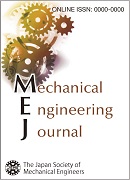Volume 1, Issue 5
Displaying 1-15 of 15 articles from this issue
- |<
- <
- 1
- >
- >|
Evolving Power and Energy Systems
-
2014Volume 1Issue 5 Pages TEP0042
Published: 2014
Released on J-STAGE: October 15, 2014
Download PDF (169K) -
2014Volume 1Issue 5 Pages TEP0043
Published: 2014
Released on J-STAGE: October 15, 2014
Download PDF (616K) -
2014Volume 1Issue 5 Pages TEP0044
Published: 2014
Released on J-STAGE: October 15, 2014
Download PDF (687K) -
2014Volume 1Issue 5 Pages TEP0045
Published: 2014
Released on J-STAGE: October 15, 2014
Download PDF (792K) -
2014Volume 1Issue 5 Pages TEP0046
Published: 2014
Released on J-STAGE: October 15, 2014
Download PDF (1231K) -
2014Volume 1Issue 5 Pages TEP0047
Published: 2014
Released on J-STAGE: October 15, 2014
Download PDF (731K)
Solid Mechanics and Materials Engineering
-
2014Volume 1Issue 5 Pages SMM0048
Published: 2014
Released on J-STAGE: October 15, 2014
Download PDF (892K) -
2014Volume 1Issue 5 Pages SMM0049
Published: 2014
Released on J-STAGE: October 15, 2014
Download PDF (6682K)
Thermal, Engine and Power Engineering
-
2014Volume 1Issue 5 Pages TEP0050
Published: 2014
Released on J-STAGE: October 15, 2014
Download PDF (685K)
Dynamics & Control, Robotics & Mechatronics
-
2014Volume 1Issue 5 Pages DR0051
Published: 2014
Released on J-STAGE: October 15, 2014
Download PDF (1809K) -
2014Volume 1Issue 5 Pages DR0052
Published: 2014
Released on J-STAGE: October 15, 2014
Download PDF (1436K) -
2014Volume 1Issue 5 Pages DR0053
Published: 2014
Released on J-STAGE: October 15, 2014
Download PDF (1375K) -
2014Volume 1Issue 5 Pages DR0054
Published: 2014
Released on J-STAGE: October 15, 2014
Download PDF (5252K)
Micro / Nano Science and Technology
-
2014Volume 1Issue 5 Pages MN0055
Published: 2014
Released on J-STAGE: October 15, 2014
Download PDF (1396K)
Transportation and Logistics
-
2014Volume 1Issue 5 Pages TL0056
Published: 2014
Released on J-STAGE: October 15, 2014
Download PDF (2399K)
- |<
- <
- 1
- >
- >|
